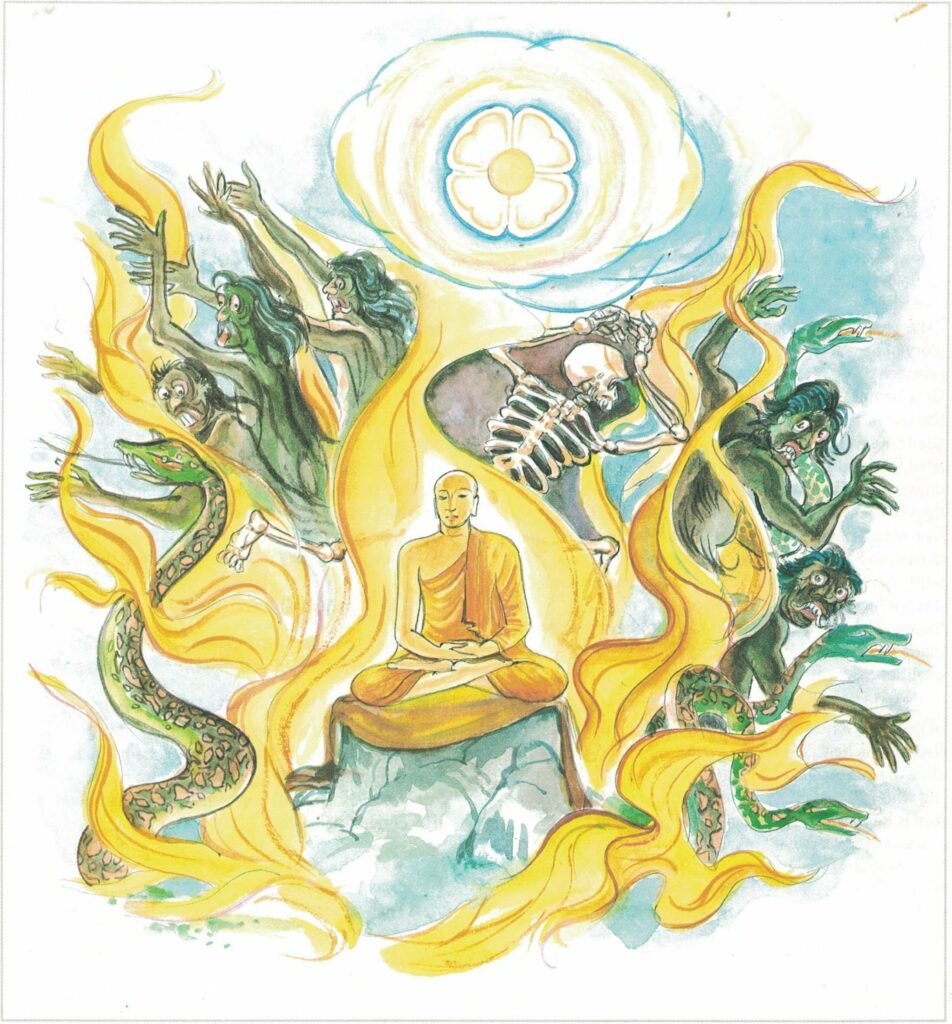Pali text, illustration and English translation of Dhammapada verse 31:
appamādarato bhikkhu pamāde bhaya dassivā |
saṃyojanaṃ aṇuṃ thūlaṃ ḍahaṃ aggīva gacchati || 31 ||
31. The bhikkhu liking heedfulness, seeing fear in heedlessness, advances as a conflagration burning fetters great and small.

The Story of a Certain Monk
While residing at the Jetavana Monastery, the Buddha spoke this verse, with reference to a certain monk.
The story goes that this monk obtained from the Teacher a meditation topic leading to arahatship and retired to the forest. Although he strove and struggled with might and main, he was unable to attain arahatship. Thereupon he said to himself, I will ask the Buddha to give me a meditation topic better suited to my needs.” So he departed from his place of residence and set out to return to the Buddha. On the way he saw a great forest fire raging. Accordingly he climbed up to the top of a bald mountain and sat down. As he watched the fire consume the forest, he concentrated his mind on the following thought, “Even as this fire advances, consuming all obstacles both great and small, so also ought I to advance, consuming all obstacles both great and small by the fire of knowledge of the noble path.”
The Buddha, even as he sat in his Perfumed Chamber, became aware of the course of his thoughts and spoke as follows, “Monk, this is precisely true. Even as fire consumes all obstacles both great and small, so also is it necessary with the fire of knowledge to consume and utterly destroy all attachments both small and great which arise within these living beings.” And sending forth a luminous image of himself, present, as it were, sitting face to face with that monk, he gave a stanza.
At the conclusion of the stanza that monk, even as he sat there, consumed all the attachments and attained Arahatship, together with the Supernormal Faculties. And straightway, soaring through the air, he approached the Buddha, praising and glorifying the golden body of the Buddha. And when he had done him homage, he departed.
Explanatory Translation (Verse 31)
appamādarato pamāde bhayadassi vā bhikkhu aṇuṃ
thūlaṃ saññojanaṃ aggī iva dahaṃ gacchati.
appamādarato [appamādarata]: taking delight in mindfulness; pamāde: in mindlessness; bhayadassi vā: seeing fear; bhikkhu: the monk; aṇuṃ thūlaṃ [thūla]: minute and large; saññojanaṃ [saññojana]: the bonds; aggī iva: like a fire; dahaṃ [daha]: burns away; gacchati: makes his way (Nibbāna).
The monk, as the seeker after truth, is frightened of mindlessness because he knows that if one is unmindful, one will be caught up in the unending sufferings of saṃsāra. Therefore, he forges ahead diligently, and mindfully burning away those bonds that fetter people to worldliness.
Commentary and exegetical material (Verse 31)
saññojanaṃ: fetters. There are ten fetters tying beings to the wheel of existence, namely: (i) personality perspective, (ii) uncertainty or split mind, (iii) alienated discipline, (iv) sensual passion, (v) hate, (vi) passion for form, (vii) passion for the formless, (viii) judgement, (ix) anxiety, (x) unawareness. The first five of these are called ‘lower fetters’, as they tie to the sensual world. The latter five are called ‘higher fetters’, as they tie to the higher worlds, i.e. the form and formless world.
He who is free from (i) to (iii) is a Sotāpanna, or Streamwinner, i.e., one who has entered the stream to Nibbāna, as it were. He who, besides these three fetters, has overcome (iv) and (v) in their grosser form, is called a Sakādāgami, a ‘Once-Returner’ (to this sensual world). He who is fully freed from (i) to (v) is an Anāgāmi, or ‘Non-Returner’ (to the sensual worlds). He who is freed from all the ten fetters is called an Arahat, i.e., a perfectly Holy One.
pamāde bhayadassi vā: he sees being unaware as conducive to fear. The fear that is seen has to do with the recurring cycle of existence. He is aware that if he relaxes in his effort to improve himself in his spiritual progress he will endlessly face births and deaths. Therefore he considers unmindfulness as the root cause of all these sufferings. This is the reason why he sees fear in lack of mindfulness.
appamāda rato: delighting in mindfulness. The truth-seeker can achieve success in his quest if he pursues it with happiness. If his delight in the deathless ceases, he will not be able to continue in his path towards Nibbāna. Therefore the monk–seeker after truth–is described as an individual who takes delight in the alertness of the mind.
Bhikkhu: A fully ordained disciple of the Buddha is called a Bhikkhu. “Mendicant monk” may be suggested as the closest equivalent for “Bhikkhu.” He is not a priest as he is no mediator between God and man. He has no vows for life, but he is bound by his rules which he takes of his own accord. He leads a life of voluntary poverty and celibacy. If he is unable to live the Holy Life, he can discard the robe at any time.